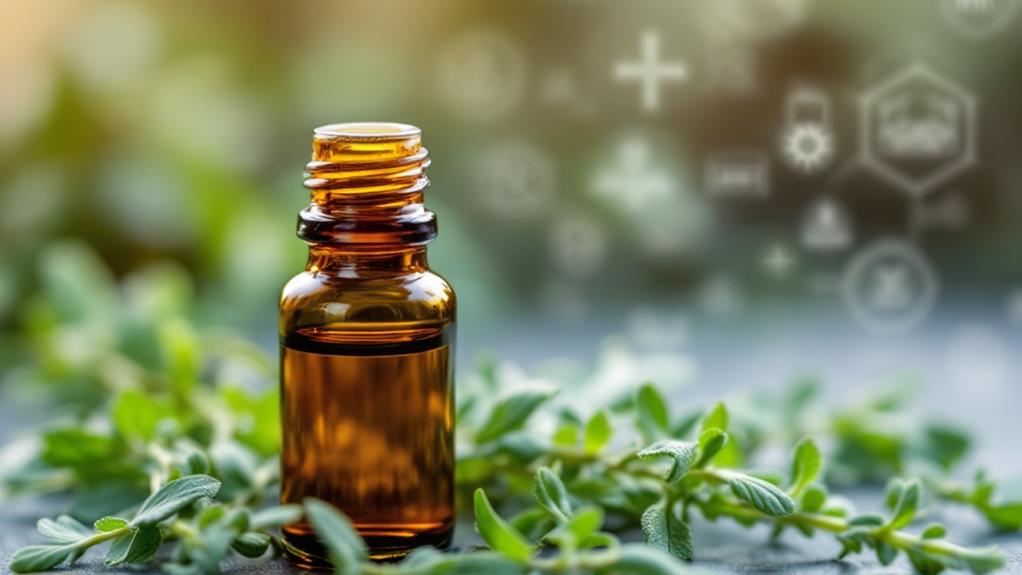What Is Candida? Symptoms, Causes, and Natural Remedies

Candida is yeast that usually lives harmlessly in your body, but certain factors can cause it to overgrow, leading to infections. Symptoms vary depending on the area affected: white patches and soreness in the mouth, itching and discharge in vaginal infections, or red rashes on the skin. Common causes include antibiotic use, high-sugar diets, and a weakened immune system. Natural remedies like garlic, coconut oil, and probiotics can help manage Candida. Eating a low-sugar, high-fiber diet also supports gut health. It's essential to understand these aspects to prevent and tackle Candida effectively. To learn more, consider examining further details.
Understanding Candida Overgrowth
Candida overgrowth often occurs when the natural balance of microorganisms in your body is disrupted. Candida, a genus of yeast, usually resides harmlessly in places like your mouth, skin, and intestines. However, when conditions favor its growth, it can lead to candidiasis, an infection with diverse symptoms depending on the affected area. One of the primary causes of this overgrowth is the disruption of healthy bacteria, often due to antibiotic use, which diminishes these beneficial organisms that typically keep Candida in check.
Other causes include high sugar and refined carbohydrate diets, hormonal changes, and a weakened immune system. When your immune system isn't at its best, it struggles to manage Candida levels, leading to possible infection. Prevention of Candida overgrowth involves maintaining a balanced diet and a healthy lifestyle to support your immune system and preserve the balance of microorganisms.
Effective treatment often includes dietary modifications to reduce sugar intake and lifestyle changes to strengthen your immune defenses. Understanding these causes and taking proactive steps can help you manage and prevent recurring Candida infections, ultimately maintaining harmony within your body's microbiome.
Common Symptoms of Candida
How can you tell if Candida is causing trouble in your body? Recognizing the symptoms of candidiasis can help you identify if this pesky yeast is at work. Oral candidiasis, also known as thrush, typically shows up as creamy white patches in your mouth and painful cracks at the corners. If you're a female, you might experience vaginal yeast infections, which often bring itchy irritation and a cottage cheese-like discharge. This type of infection affects about 20% of females at some point.
Skin candidiasis can cause rashes in warm, moist parts of your body like the groin, under the breasts, or between fingers and toes. These rashes usually present with redness and persistent itching. When Candida overgrowth spreads, it can lead to systemic infections, resulting in joint pain or chronic fatigue syndrome.
Digestive issues are another sign of Candida overgrowth. You might experience bloating, constipation, or diarrhea as your gut struggles to maintain balance. Being aware of these symptoms can guide you toward addressing the root cause and finding relief. Taking note of these signs helps you take control and seek appropriate solutions to restore your health.
Factors Leading to Candida

When you investigate the factors leading to Candida overgrowth, it's clear that lifestyle and health choices play a crucial role. One major trigger is the use of antibiotics. While they fight infections, antibiotics can also disrupt the balance of healthy bacteria in your body, giving yeast like Candida the opportunity to thrive. Diet is another critical factor; consuming high amounts of sugar and refined carbohydrates provides the perfect environment for Candida growth, as yeast flourishes on sugar.
A weakened immune system can greatly increase your risk of Candida overgrowth. Conditions like HIV, uncontrolled diabetes, or certain medications that suppress immune function allow Candida to multiply unchecked. Hormonal changes, such as those experienced during pregnancy or when taking oral contraceptives, can also contribute to this imbalance, promoting Candida overproduction.
Stress and lifestyle choices further disrupt the balance of healthy bacteria. Poor diet and lack of sleep exacerbate stress, which in turn facilitates Candida overgrowth. To combat these factors, consider natural remedies that promote a balanced internal environment. By addressing these key contributors, you can take proactive steps to manage and potentially prevent Candida overgrowth in your life.
Types of Candida Infections
Understanding what causes Candida overgrowth sets the stage for recognizing the different types of infections it can lead to. Candida infections manifest in multiple forms, each with distinct symptoms. Vaginal candidiasis affects about 20% of women, presenting with itching, burning, redness, and a cottage cheese-like discharge. Oral candidiasis, or thrush, shows up as white patches in your mouth and throat, causing pain and difficulty swallowing.
Cutaneous candidiasis occurs on the skin, thriving in warm, moist areas like under the breasts or in the groin. You'll notice red, itchy rashes and possibly blisters. In more severe cases, invasive candidiasis can develop, which affects the bloodstream and internal organs. This type is serious and often seen in hospitalized patients or those with weakened immune systems. Finally, Candida granuloma, a chronic form, impacts the skin, scalp, mouth, or nails, causing painful lesions.
The balance between yeast and healthy bacteria is vital to prevent candidiasis. Effective treatment for Candida involves addressing the underlying causes. By understanding the symptoms of Candida and how it causes infection, you can take steps to manage and prevent candidiasis effectively.
Diagnosing Candida Infections

Why is diagnosing Candida infections so essential for effective treatment? Getting an accurate diagnosis is key because the symptoms of Candida overgrowth often overlap with other conditions. A healthcare provider will typically start with a thorough visual examination of the affected area to identify signs of Candida overgrowth, such as white patches in cases of oral thrush. This step helps guarantee the correct treatment path is taken.
Here's how the diagnosis process usually unfolds:
- Visual Examination: Your healthcare provider checks the affected area for recognizable symptoms that suggest Candida overgrowth. For oral thrush, this involves looking for white patches or lesions in the mouth and throat.
- Swab and Culture Tests: A swab of the infected area is often taken to perform culture tests. This helps identify the specific type of Candida causing the infection, guiding targeted treatment decisions.
- Further Testing: In some cases, such as suspected esophageal candidiasis, an endoscopy might be performed. This procedure allows for a closer look at the esophagus and the option to take tissue samples if needed.
Conventional Treatment Methods
Accurate diagnosis sets the stage for effective treatment of Candida infections, highlighting the significance of conventional methods. To tackle these infections, antifungal medications are your primary line of defense. Depending on the severity and location, these medications can be administered topically or orally. For oral thrush, nystatin is commonly used, while miconazole and clotrimazole work well for topical applications. In cases of systemic infections, fluconazole is often prescribed.
For mild vaginal infections, over-the-counter options might suffice, resolving symptoms typically within 2-3 days. However, if you're dealing with severe or recurrent cases, prescription-strength medications are necessary. Sometimes, treatment duration can extend to weeks or require intravenous therapy for the most stubborn infections.
The significance of a precise diagnosis cannot be overstated. Culture tests are often employed to identify the specific strain of Candida, ensuring that your antifungal approach is tailored effectively. This step is vital because it guides the choice of medication and helps in determining the appropriate treatment duration. By following these conventional methods, you're more likely to achieve lasting relief from Candida infections.
Natural Remedies for Candida

Release the potential of natural remedies to tackle Candida infections effectively. By leveraging ingredients with antifungal properties, you can manage Candida overgrowth naturally. Here are some powerful options to contemplate:
- Garlic, Coconut Oil, and Apple Cider Vinegar: These are natural remedies with potent antifungal properties that can help you combat Candida overgrowth. Incorporating them into your daily routine may provide significant advantages.
- Probiotics: Strains like Lactobacillus and Bifidobacterium can restore healthy gut flora, promoting gut health and potentially preventing future Candida infections. Including probiotic-rich foods or supplements in your diet can be a game-changer.
- Herbal Remedies: Oils such as oregano and tea tree have shown promising antifungal effects. While more human studies are needed, these herbal remedies might be a valuable enhancement to your Candida-fighting arsenal.
Supporting your immune function is paramount in managing Candida infections. Reflect on supplements like vitamin D and fundamental fatty acids, which can elevate your body's defenses. Moreover, maintaining a low-sugar diet is important, as it limits Candida's food sources and supports comprehensive gut health. By focusing on these natural remedies, you can take a proactive approach to manage Candida effectively.
Dietary Changes for Candida
Transform your diet to effectively manage Candida overgrowth by focusing on foods that combat yeast proliferation and support gut health. Start by reducing your intake of refined sugars and carbohydrates, as they can fuel the growth of Candida. Instead, opt for a diet high in antifungal foods like garlic, coconut oil, and apple cider vinegar. These foods can help inhibit Candida proliferation and contribute to a balanced internal environment.
Incorporate probiotics into your meals to restore healthy gut flora. Fermented foods such as yogurt and sauerkraut are excellent sources of probiotics and can bolster your immune system, providing a defense against Candida infections. Avoiding dairy products, processed meats, and alcohol is vital, as these can exacerbate symptoms and disrupt gut bacteria balance.
Embrace a high-fiber diet rich in vegetables, whole grains, and legumes. Fiber aids in promoting digestive health and supports your body's natural detoxification processes, which are fundamental in managing Candida. By making these dietary changes, you can take a proactive approach to managing Candida overgrowth and fostering a healthier gut environment. Remember, your choices at the table greatly impact your comprehensive health and well-being.
Prevention Strategies

Preventing Candida overgrowth involves a few simple yet effective strategies that focus on maintaining a balanced lifestyle. Start by paying attention to your diet. A balanced diet low in refined sugars and carbohydrates can help prevent Candida overgrowth, as these foods are known to promote yeast growth. By choosing whole foods and minimizing sugar intake, you support a healthier environment for your body.
Next, consider including probiotics into your daily routine. Probiotics, often found in fermented foods like yogurt and kefir, can restore healthy gut flora and balance your microbiome, making it harder for Candida to thrive. Regular consumption of these foods strengthens your defenses against overgrowth.
Finally, don't overlook the importance of managing stress. Stress management through mindfulness, exercise, and adequate sleep bolsters your immune system, reducing susceptibility to Candida infections. Furthermore, keep an eye on your blood sugar levels, especially if you have diabetes, as high glucose levels can encourage Candida proliferation.
To summarize, here are three key strategies to prevent Candida overgrowth:
- Adopt a balanced diet low in refined sugars.
- Include probiotics to support healthy gut flora.
- Practice good hygiene and manage stress effectively.
When to Seek Medical Advice
Knowing when to seek medical advice for Candida symptoms is essential for effective treatment. If you experience persistent itching, burning, or unusual discharge, these could be signs of a yeast infection needing prompt attention. Don't hesitate to consult a healthcare provider if over-the-counter antifungal treatments fail to offer relief within three days. These symptoms might indicate a more severe candidiasis or another underlying issue that requires stronger prescription medications.
Individuals with compromised immune systems, such as those with diabetes or HIV, should be particularly vigilant. At the initial sign of candidiasis symptoms, consult your healthcare provider. Your immune system might not be able to handle the overgrowth, leading to more serious infections. It's important to prevent complications by seeking medical advice early.
Additionally, if you notice recurring candidiasis symptoms, it's time for a medical consultation. Identifying underlying causes and adjusting treatment strategies can help manage these frequent episodes. Symptoms that disrupt daily activities like eating or sleeping are also red flags. Such disruptions can indicate a severe infection that necessitates immediate medical intervention. Remember, timely consultation with your healthcare provider can prevent complications and provide effective treatment.




